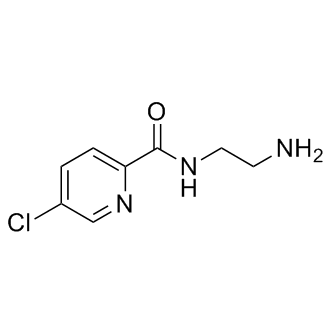| Cas No.: | 103878-84-8 |
| Synonyms: | Ro 19-6327/000 |
| SMILES: | ClC1=CC=C(C(NCCN)=O)N=C1 |
| Formula: | C8H10ClN3O |
| M.Wt: | 199.6375 |
| Purity: | >98% |
| Sotrage: | 2 years -20°C Powder, 2 weeks 4°C in DMSO, 6 months -80°C in DMSO |
| Description: | Lazabemide(Ro 19-6327/000) is selective, reversible monoamine oxidase B (MAO-B) inhibitor (IC50 values are 0.03 and > 100 μM for MAO-B and MAO-A respectively). in vitro: The in vitro binding characteristics of both radiolabeled inhibitors revealed them to be selective, high-affinity ligands for the respective enzymes. KD and Bmax values for 3H-Ro 41-1049 in rat cerebral cortex were 10.7 nM and 7.38 pmol/mg protein, respectively, and for 3H-Ro 19-6327 were 18.4 nM and 3.45 pmol/mg protein, respectively. The IC50 values for lazabemide and Ro 16-6491, respectively, were: 86 microM and 90 microM for NA uptake; 123 microM and 90 microM for 5HT uptake; > 500 microM and > 1000 microM for DA uptake. Lazabemide and Ro 16-6491 also differed from L-deprenyl in their ability to induce release of endogenous monoamines from synaptosomes. Thus, Ro 16-6491 (500 microM) induced a greater 5 HT release than did L-deprenyl, but was less effective than L-deprenyl in releasing DA. On the contrary, lazabemide was almost completely inactive on either 5 HT and DA release. a clear inhibition of DOPAC formation was observed with Ro 41-1049 (250 nM), while 250 nM lazabemide was found not to increase the accumulation of newly-formed DA in those tubular epithelial cells loaded with 50 microM L-DOPA. in vivo: The ischemia reperfusion-induced hydroxyl radical generation was attenuated by 3 mg/kg of clorgyline and lazabemide. Furthermore, mice pretreated with these MAO inhibitors showed decreased DOPAC levels in comparison with those of their respective vehicle-treated control groups; recovery of the reduced DOPAC level was also delayed. |

 To enhance service speed and avoid tariff delays, we've opened a US warehouse. All US orders ship directly from our US facility.
To enhance service speed and avoid tariff delays, we've opened a US warehouse. All US orders ship directly from our US facility.




















